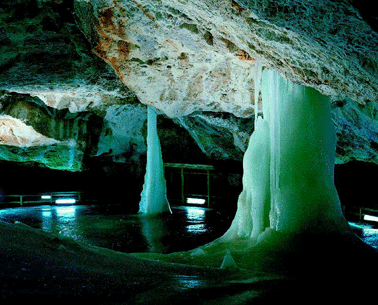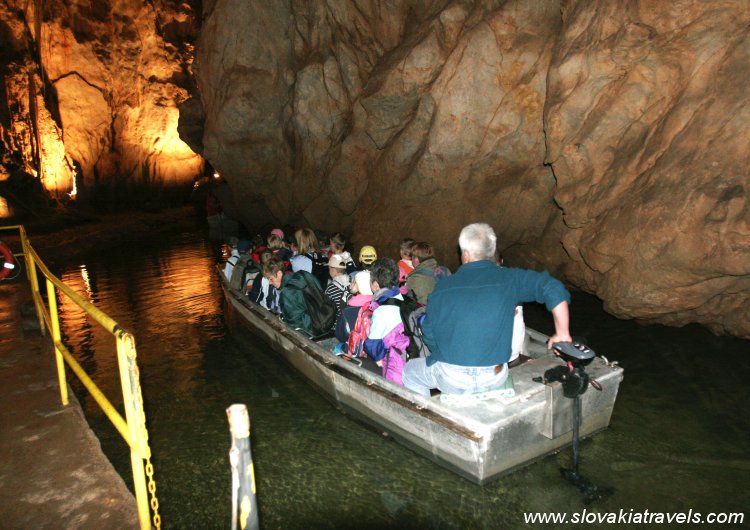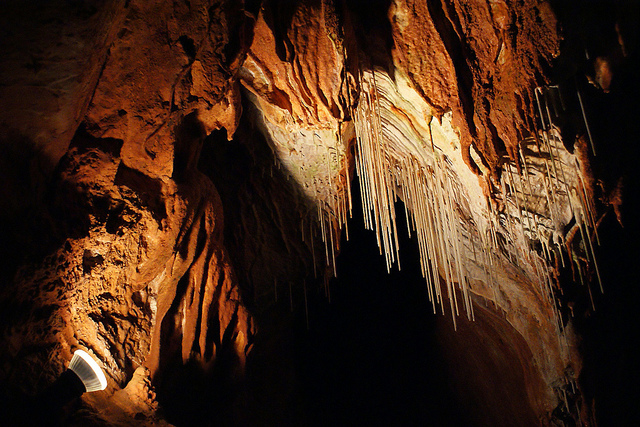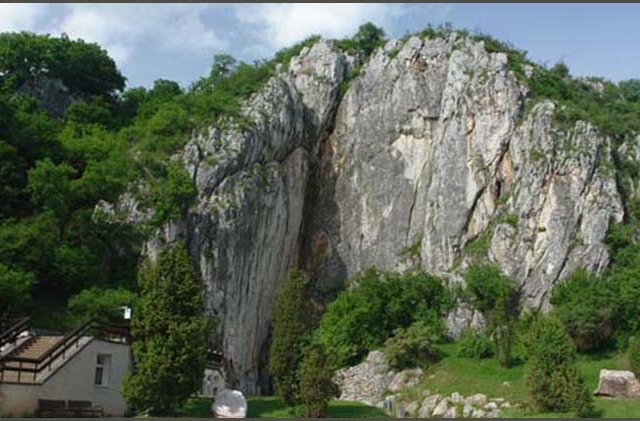Caves of the Slovakian Karst
Dobsina Ice Cave
Dobšinská Ice Cave is a part of the Stratená Cave System. It is formed in the Middle Triassic pale Steinalm and Wetterstein limestones of the Stratená Nappe, along the tectonic faults and structural breaks. The cave is 1483 m long and 112 m deep.
The main part of the cave consists of a giant cavity descending from the entrance to the depth of 70 m. This particular section formed as the result of the collapse of the columns suspending the ceiling. The columns themselves were formed by millennia of erosion caused by the underground flow of the Hnilec River. At present, much of the cave is filled by glacial ice, sometimes up to the ceiling. However, there are several accessible areas of dazzling beauty and interest, including the Great and Small Hall, Ruffiny’s Corridor and the Ground Floor. The Collapsed Dome is partly glaciated, and its north-western edge  reaches under the Duča Chasm. The original oval forms resulting from river modelling are almost entirely destroyed or obscured by collapses and frost weathering.
reaches under the Duča Chasm. The original oval forms resulting from river modelling are almost entirely destroyed or obscured by collapses and frost weathering.
 reaches under the Duča Chasm. The original oval forms resulting from river modelling are almost entirely destroyed or obscured by collapses and frost weathering.
reaches under the Duča Chasm. The original oval forms resulting from river modelling are almost entirely destroyed or obscured by collapses and frost weathering.The upper non-glaciated parts of the cave are comprised of prevailingly horizontal passages and halls with typical oval shapes and ceiling channels. Speleothems in the non-glaciated parts of the cave include stalagmites, stalactites, flowstone crusts and layers of moonmilk.
Conditions for glaciation probably arose in the middle Quaternary Period after ceiling failure between the Dobšinská Ice Cave and Stratenská Cave, by which the cave obtained a sack-like character. Cold air penetrating through the upper opening (now the entrance) stagnated. Furthermore, percolating rainfall contributed to the glaciation of the underground space. The beginnings of ice formation go back to the Riss Ice Age (approx. 300- to 140-thousand years ago), or until the end of the Mindel Ice Age.
Ice fill occurs in the form of floor ice, icefalls, ice stalagmites and columns. The glaciated surface is 9,772 m2, while ice volume reaches 110,100 m3. The greatest thickness of ice, 26.5 m, is in the Great Hall. Floor ice is characterised by its stratification. The decrease of ice through ice melt occurs on contact with the bedrock. Complete replacement of the underground glacier supposedly takes around 1700 - 2000 years. The ice is slowly retreating from the entrance and the Small and Great Hall towards the Ground Floor and Ruffiny’s Corridor (2-4 cm a year). The Dobšinská Ice Cave belongs among the most significant ice caves in the world, accentuated by its location outside the Alps high-mountain region (underground ice is at an elevation of 920-950 m).
The average annual temperature of air in the glaciated Great Hall is –0.4 to –1.0 °C (in February –2.7 to –3.9 °C, in August around +0.2 °C). The temperature in the bottom parts of the cave remains under the freezing point all year round. Relative air humidity in non-glaciated parts is mostly 75-90%, but occasionally over 90%. Air temperature in the non-glaciated parts of the cave fluctuates between +0.8 and +3.5 °C, with relative humidity between 85-98%. The cave is of a static-dynamic character, meaning that air circulation is different in winter and summer. In winter the cold air flows from the surface underground into the cave, and vice versa in summer.
The cave is the most important wintering place of the Whiskered Bat (Myotis mystacinus) and Brandt’s Bat (Myotis brandtii) in the Central Europe. Among the 12 species of bat found in the cave, the Pond Bat (Myotis dasycneme) and Natterer’s Bat (Myotis nattereri), are amongst the rarest bat species in Slovakia.
The cave is formed in the Middle Triassic pale Wetterstein limestone of the Silica Nappe along the tectonic faults through the corrosive and erosive activities of the Styx Brook, Domický Brook and smaller underground tributaries draining waters mainly from the non-karst part of the basin. Horizontal oval passages with ceiling troughs dominate the cave’s scenery. The passages widen into domes and halls in some sections. The passage of the Styx has formed almost a meandering underground canyon. The cave has developed on three distinct levels, each about 8-12 m apart. However, the lowest level is filled with gravel and loam.
Domica Cave is connected with the Čertova diera Cave, and together they approach 5358 m in length.  They also form one genetic unit with the Baradla Cave in Hungary with the total length of about 25 km, of which almost one quarter is in Slovakian territory.
They also form one genetic unit with the Baradla Cave in Hungary with the total length of about 25 km, of which almost one quarter is in Slovakian territory.
 They also form one genetic unit with the Baradla Cave in Hungary with the total length of about 25 km, of which almost one quarter is in Slovakian territory.
They also form one genetic unit with the Baradla Cave in Hungary with the total length of about 25 km, of which almost one quarter is in Slovakian territory.The cave is rich in sinster (a rock made of very fine-grained silica) forms, the most typical being shields and drums, cascade pools (such as those seen at the Roman Spa – Rímske kúpele, Plitvice Lakes – Plitvické jazierka), onion-like stalactites and pagoda-like stalagmites. Air temperature ranges from 10.2 to 11.4°C and relative humidity from 95-98%.
The bones of a cave bear (Ursus spelaeus) were dug out from sediments in the Dry Passage. Sixteen bat species have been found in the Domica Cave and Čertova diera Cave so far. The dominat bat species is the Mediterranean Horseshoe Bat (Rhinolophus euryale). The Mediterranean Horseshoe Bat colony is the only one in Slovakia, and consists of 1200-1400 members. Thick layers of bat guano can be found in some places. Its chemical reaction with the sinter deposits has created guano pots. Forty-four species of collembolans/springtails (the most important being the Arrhopalites slovacicus) have been found in this cave together with rare palpigrade Eukoenenia spelaea, multipedes of the Typhloiulus sp. genus, Niphargus tatrensis crustaceans, and many other species of land and water fauna.
Gombaszögi Cave
The Gombaszögi Cave was formed in the Middle Triassic pale Wetterstein limestones and dark-grey Gutenstein limestones along the tectonic faults through the corrosive and erosive activities of the Black Brook and its intermittent tributary from the well in the Marble Hall. The Gombaszögi Cave and Silická Ice Cave are part of the Silica-Gombasek underground hydrological system. The two caves are separated by a section of the Black Brook which emerges above ground through the Black Spring, 11 m above the bottomland of the Slaná River (Sajó River).
The Gombaszögi Cave represents a fluviokarst 1525 m long outlet cave. The two levels consist of oval passages formed by running water and fissures. In some places, these passages have widened too far and collapsed, thus forming domes and halls. The upper floor is situated 5-10 m above the active riverbed of the Black Brook, which flows in the lower parts of the cave. The Dry Passage, located on the upper floor, was formed by waters of unknown origin which still intermittently rise through the 10 m deep well in the Marble Hall.
The cave is special for its unique (up to) 3 m long thin straw stalactites. Other forms of stalactites, stalagmites, sinter curtains, coatings and crusts can also be found here. Air temperature in the cave ranges between 9.0 and 9.4 ºC (48-49 ºF), and relative humidity between hovers between 95-97%.
One of the remarkable findings in the cave is a blind 26 mm long Typhloiulus sp. genus multipede, which represents the biggest troglobite – or actual cave animal ever found in a Slovakian cave. Of course bats such as the Smaller Horseshoe Bat are also occasionally present in the cave in spring or autumn. In recent years, fire salamanders (Salamandra salamandra) have been dwelling in the entrance passage from autumn to spring.
Jászói Cave
The Jasovská Cave was formed in Middle Triassic grey Gutenstein dolomites, pale Steinalm limestones  and dolomites of the Silica Nappe. The massif of the Jasov Rock is markedly disrupted by faults and numerous fissures, thus determining the condition, prevailing direction, and to great extent also the number of passages in the cave. The Jasovská Cave is 2811 m long with a 55 m gradient.
and dolomites of the Silica Nappe. The massif of the Jasov Rock is markedly disrupted by faults and numerous fissures, thus determining the condition, prevailing direction, and to great extent also the number of passages in the cave. The Jasovská Cave is 2811 m long with a 55 m gradient.
 and dolomites of the Silica Nappe. The massif of the Jasov Rock is markedly disrupted by faults and numerous fissures, thus determining the condition, prevailing direction, and to great extent also the number of passages in the cave. The Jasovská Cave is 2811 m long with a 55 m gradient.
and dolomites of the Silica Nappe. The massif of the Jasov Rock is markedly disrupted by faults and numerous fissures, thus determining the condition, prevailing direction, and to great extent also the number of passages in the cave. The Jasovská Cave is 2811 m long with a 55 m gradient.The underground spaces were formed progressively in several development phases from the highest passages to the lowest parts of the cave in relation to the development of the Bodva River valley. The upper and some bottom parts of the cave with high meandering passages and halls with ceiling troughs were formed by the corrosive and erosive activities of ancient waters of Bodva. The lower parts of the cave with domes, halls, wall notches and flat ceilings were formed by more or less stagnant water. The lowest parts of the cave with flat ceilings were formed by the dissolution of limestone through the activity of slowly moving or stagnant water.
The lowest parts of the cave, including a section where the tourist path presently lies, used to be flooded as the consequence of water-table fluctuations. The lowest level of cave lake is 7 m below the surface level of the Bodva River, which doesn’t currently flow through the cave. An occasional flooding of the cave’s lower parts does not correlate with the Bodva River’s fluctuations.
Several parts of the cave are embellished with rich flowstone fill. Pagoda-like stalagmites, columns, flowstone waterfalls, shields, drums, straw stalactites and other forms are very eye catching. Air temperature ranges between 8.8 and 9.4 ºC, and relative humidity ranges between 90 and 98%.
Bones of ancient cave bears (Ursus spelaeus) and cave hyenas (Crocuta spelaea) were found in the cave. Nowadays, the Jasovská Cave is a very important bat locality. Eighteen bat species have already been found in the cave, primarily residing there in winter. The most abundant bats are the Greater Horseshoe Bat (Rhinolophus ferrumequinum) and Lesser Horseshoe Bat (Rhinolophus hipposideros). The cave is one of the most important wintering places of the Greater Horseshoe bats in Slovakia. A tiny palpigrade Eukoenenia spelaea (an arachnid) represents the rare invertebrates.
Ochtinai-Aragonit Cave
The Ochtinai-Aragonit Cave was formed in a layer of Palaeozoic Devonian crystalline limestone situated  amidst non-karst rocks (phyllites). The entrance to the cave is 642 m above sea level. The upward narrowing passages and halls were formed by the corrosive activities of rainwater percolating along distinct tectonic faults. Horizontal passages and halls located between tectonic faults originated mostly as a consequence of slowly flowing water corroding the surrounding rock, and the mixing of waters of various temperatures and chemical composition. These features created plentiful irregular niches and ceiling cupolas. Along the previous level of the stagnated water table (which later declined), side corrosion notches and corroded ceilings were formed.
amidst non-karst rocks (phyllites). The entrance to the cave is 642 m above sea level. The upward narrowing passages and halls were formed by the corrosive activities of rainwater percolating along distinct tectonic faults. Horizontal passages and halls located between tectonic faults originated mostly as a consequence of slowly flowing water corroding the surrounding rock, and the mixing of waters of various temperatures and chemical composition. These features created plentiful irregular niches and ceiling cupolas. Along the previous level of the stagnated water table (which later declined), side corrosion notches and corroded ceilings were formed.
 amidst non-karst rocks (phyllites). The entrance to the cave is 642 m above sea level. The upward narrowing passages and halls were formed by the corrosive activities of rainwater percolating along distinct tectonic faults. Horizontal passages and halls located between tectonic faults originated mostly as a consequence of slowly flowing water corroding the surrounding rock, and the mixing of waters of various temperatures and chemical composition. These features created plentiful irregular niches and ceiling cupolas. Along the previous level of the stagnated water table (which later declined), side corrosion notches and corroded ceilings were formed.
amidst non-karst rocks (phyllites). The entrance to the cave is 642 m above sea level. The upward narrowing passages and halls were formed by the corrosive activities of rainwater percolating along distinct tectonic faults. Horizontal passages and halls located between tectonic faults originated mostly as a consequence of slowly flowing water corroding the surrounding rock, and the mixing of waters of various temperatures and chemical composition. These features created plentiful irregular niches and ceiling cupolas. Along the previous level of the stagnated water table (which later declined), side corrosion notches and corroded ceilings were formed.Three generations of aragonite were formed in the cave resulting from water solutions with high contents of magnesium, iron and manganese ions under stabile microclimate conditions. The oldest are milky translucent kidney-shaped formations and their corroded remains (121-138 thousand years old) with partially re-crystallised aragonite, which in some places metamorphosed into calcite. The second generation of aragonite prevails and occurs mostly in the form of several centimetre long needles and spiral helictites (about 14 thousand years old). These aragonites are characterised by eye-catching clusters or dentritic formations (including so-called “cave flowers” or anthodites). Since this aragonite is still growing, it maintains a white and clean appearance. The youngest, contemporary aragonite structures are tiny fans of 2–4 mm (sometimes even more) diameter sporadically creating miniature helictites of not more than 40 mm in length.
The air temperature in the cave is between 7.2 and 7.8 ºC, with relative humidity standing between 92-97%. Stabilisation of the cave microclimate is caused by ochres that contain 47-56 percent water by volume, and are therefore able to both absorb and release water vapour.

